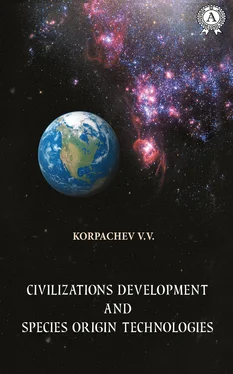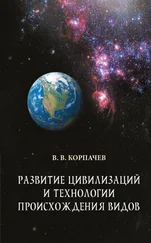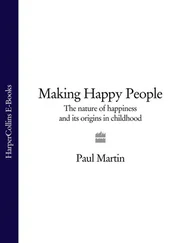Judging by the palaeontological chronical and by the mutations’ speed indexes, this concept advocates believe that it takes in average 3 million years to reach the complete incompatibility of genomes, which makes crossing impossible. Therefore, it is a rear event to witness the new specie’s formation in natural environment.
In addition to mutational, there is also the combinatorial variability distinguished, which is determined by recombination, but it leads not to the allele frequencies’ changes but to their new combinations.
The gene drift is one more factor contributing to the allele frequencies’ changes.
The synthetic theory of evolution differs from the Ch. Darwin’s evolution in the following points:
1. It distinguishes a population in which the same species individuals are able to interbreed, and but not an individual or a separate species.
2. It considers a steady change in the population genotype’s change the process of evolution.
3. Mutational processes and isolation are treated as the leading factors.
4. The mutational and recombinative variability are the material for evolution.
5. Natural selection is considered as the main reason for the adaptations and speciation’s development.
In accordance with the synthetic theory of evolution speciation is a time-consuming process. However, J. B. S. Haldane found a discrepancy between the real speciation speed and the expected one based on the population genetics models (Haldane’s dilemma) by means of mathematical calculations. He published an article «Cost of Natural Selection» on the basis of his research in the «Journal of Genetics» scientific edition. D. Haldane calculated the mathematical relationship between the intensity of selection and rate of the existing alleles’ substitution in the population by other, more adapted ones. He also evaluated the mortality rate caused by the positive natural selection, while maintaining the mutant gene. According to his calculations, the speciation would have taken much more time for the stage-to-stage formation than it has actually taken (according to the paleontological data) for the implementation of speciation would require much more time than is actually observed (according to palaeontological data).
Later, M. Kimura, while studying the rate of amino acid substitutions in proteins, found that for mammals the substitution rate for the genome per generation was several hundred times higher than the Haldane’s estimation. Kimura showed that in order to maintain a constant population size while preserving mutational substitutions, the rate of occurrence of which stands to one substitution in two years, each parent should produce 3.27 106 descendants so that one of them survives and begins to breed. The mismatch of this impressive number with real data served as the basis for the «Neutral Molecular Evolution Theory» development.
Another argument in favour of this theory’s development was the fact that the assumption regarding more frequent occurrence of favourable mutations (in reality, such mutations are rather rare compared to the adverse ones) was necessary in order to explain the molecular evolution rate provided it proceeds under the natural selection influence.
The «neutral evolution» hypothesis’ main content lies in the point that majority of the changes at the macromolecular level are not controlled by natural selection as Darwin’s theory states, but are determined by the random drift of neutral mutations. According to the authors, this theory is proved by a number of direct and indirect arguments. At the same time, the neutral molecular evolution theory does not turn down the role of natural selection in the development of life on Earth, but emphasizes the proportion of mutations that possess adaptive significance. This theory has demonstrated that the processes associated with speciation are still far from a final explanation based on population-genetic models.
Modern synthetic theory of evolution has a number of disadvantages. It makes no distinction between macroevolution and microevolution, considering one the continuation of other one on a larger scale. Such view’s advocates have detected genetic changes from the population’s original composition from generation to generation, in various laboratory scientific experiments, including the model organisms’ development (drosophila, mice, and bacteria). It gave the grounds to assume that both microevolution and macroevolution are based on the same mechanisms and, in their view, minor changes can lead to significant ones over time, but the authors provide no evidences to prove it. Experts have no doubts regarding the microevolutionary processes within the species, for example, the hair colour or skin colour change, the beak shape, etc., due to which many types of breeds and sorts can exist within the same species. However, microevolution is determined by the alleles frequency’s change in a population (i.e. genetic variability due to such processes as selection, mutation, genetic drift), while the macroevolution involves changes at the species level or higher.
Fred Hoyle argued in his books «The Intelligent Universe» (1983), «Mathematics of Evolution», «Evolution from Space» (1981) and «Why Neo Darwinism Does Not Work» (1982), that the calculation results state that the Neo-Darwinism theory either does not work at all, or works only partially. Many of the common arguments that biologists use to confirm evolutionary theory turn out to be doubtful.
Academician Yu. P. Altukhov (Алтухов Юрий Петрович), a Director of the Russian Academy of Sciences’ Institute of General Genetics named after N. I. Vavilov, the «Successes of Modern Biology» journal editor-in-chief, points out in his book «Genetic Processes in Populations» (2003) criticizing the synthetic theory of evolution:
«In any case, it is becoming more and more obvious that evolutionary consequences are not necessarily concluded from the results of a study of both natural and experimental populations with their systemic organization taken into account. On the contrary, it confirms once again that the genetic variability of the simplest populations, traditionally regarded as the evolutionary process’s elementary units, is nothing but a stabilization mechanism for the species’ hierarchical, historically formed structure. Such a conclusion contrasts with the population genetics’ tradition, which has always been focused on the dynamics of populations, identifying it with the very evolutionary process».
However, the synthetic theory of evolution still remains the only scientific model to explain the known facts of the species’ origin and development. At the same time, the contradictions accumulated require the development of other theoretical concept of the of life occurrence on Earth.
1.4. THE THEORY OF EVOLUTION’S DISPUTABLE ISSUES
Many scientific researchers have been focused on the evolution doctrine’s problems, but it is absolutely clear that the unity of opinion regarding all its provisions has not been achieved yet. A rather general descriptive definition of the term «evolution» is the only aspect that arises no discussions. Many of the evolutionary theory critics drew attention to the low, in their opinion, probability of certain facts and events in the living beings’ development.
Among the number of the Darwinism critics appeared immediately after its appearance, the Russian philosopher N. Ya. Danilevsky is worth paying special attention, who carefully analyzed all the papers by Charles Darwin, as well as the critical papers related to them and introduced his own views on evolution. In his three-volume work, «Darwinism. A Critical Study» (1885), containing almost 1,500 pages, he comprehensively criticized Darwin’s doctrine. He wrote the following: «On the one hand, it is impossible for a mass of accidents not related to each other, to produce order, harmony, and surprising expediency; on the other hand, a talented scientist, having all the data of science and extensive personal experience in hand, shows you in a clear and obvious way how simple, however, it can be done. Only after a long study and even longer consideration I saw the fi st way out of this dilemma, and it was a great joy for me. Then a lot of such exits had been opened so that the entire theory building was riddled with, and fi ally fell apart in my eyes into an incoherent pile of garbage».
Читать дальше












